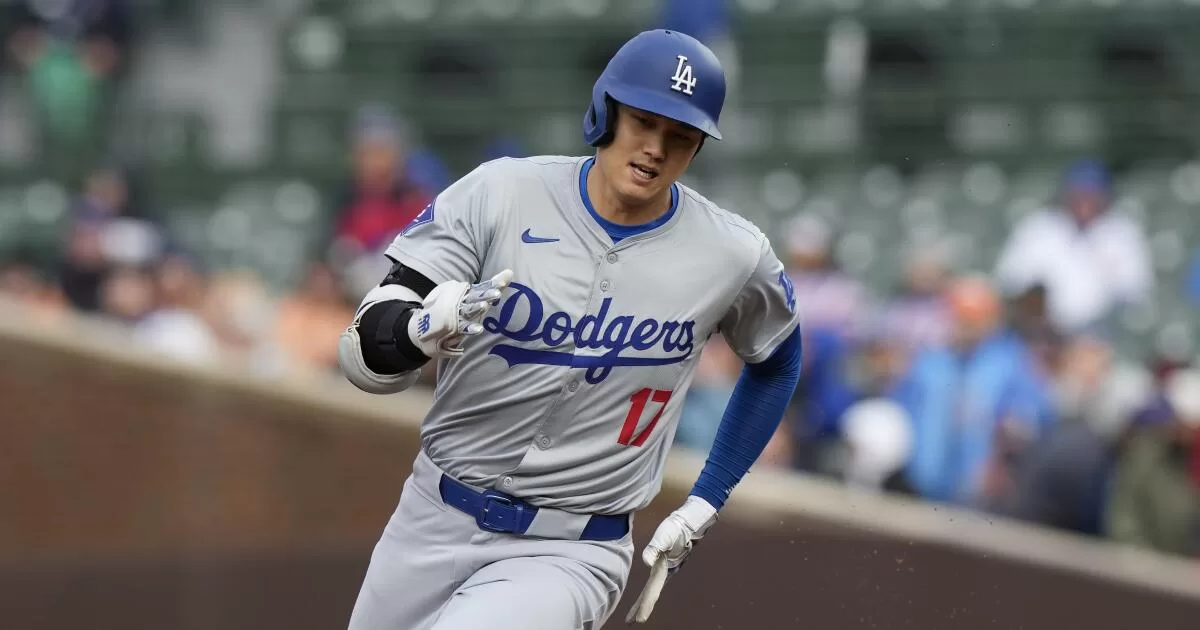“He’s very close,” the manager said then. “I expect this to continue.”
With six hits, two doubles, one triple, three RBIs and another home run from Ohtani in the three games since, Roberts is now sure of it.
“I think he’s in it,” Roberts said at the end of the Dodgers’ weekend series against the Chicago Cubs, in which Ohtani’s early season batting average catapulted by 50 points, from .270 to .320, during his first career trip to Wrigley Field.
“With the wind blowing in, he could have had a couple homers this series,” Roberts added. “So yeah, he’s right on time. And I think he’s cleaned up his mechanics.”
It’s hardly a surprise development from a player with two MVP awards and a record-breaking $700 million contract. Even during a quiet opening week at the plate, when Ohtani’s timing and mechanics looked slightly off during an eight-for-33 start to the season, Roberts said the club was expecting rapid progression.
“He’s just so talented,” Roberts said a week ago. “The hits, the slug, all that stuff will happen.”
Did they ever.
Ohtani entered play Monday in the midst of four straight multihit games.
The first two games of that stretch included his first two Dodgers home runs — a 430-foot laser against Taylor Rogers of the San Francisco Giants last Wednesday, then a towering two-run blast off Cubs right-hander Kyle Hendricks two days later.
The last two days were equally productive, with the two-way star reaching safely three times in a Saturday win before hitting a double and triple in Sunday’s rain-delayed loss.
“I’ve changed some things, made adjustments,” Ohtani said in Japanese on Monday. “I’ve tested them out in drills in the cage.”
One nontraditional tool that helped Ohtani during the middle of Sunday’s rain delay: a cricket bat.
After making outs in his first two at-bats before the rain, he spent part of the nearly three-hour delay in the batting cages, using the flat-paddled cricket bat to help hone his swing plane.
“I swung a cricket bat and got two hits [when the game resumed],” Ohtani said with a laugh Monday afternoon. “I’m thinking about doing it again today.”
The more important factor behind Ohtani’s recent hot streak, however, seems to be the sense of relief he felt after depositing his first home run as a Dodger into the Chavez Ravine seats.
Ohtani acknowledged there was a mental burden that was lifted after breaking his eight-game home run drought.
“I think the biggest difference is the ease with which you can stand in the batter’s box,” Ohtani said.
Roberts sensed a mentality change in Ohtani, as well, from the moment he was greeted in the dugout that night with a shower of sunflower seeds.
“I could see the relief in his eyes,” Roberts said.
Since then, Roberts has seen plenty of other promising changes. He noted that Ohtani has been chasing less and attacking hittable pitches with more consistent, confident swings.
“With super athletes, I guess I’ve learned that you just don’t become surprised,” Roberts said. “Shohei is just a different athlete. He really is.”
Throwing program update
As far as his pitching goes, Ohtani remains a long way from returning to the mound. The team is still targeting a 2025 comeback date from his second Tommy John surgery.
However, Ohtani said he is “little by little increasing the intensity” of his throwing program, which began a couple of weeks ago with soft sessions of catch every other day.
“It’s a small step,” Ohtani said. “But … I feel it’s progressing well.”
On Monday, Ohtani also addressed the increasing number of high-profile pitching injuries that have plagued the sport this season.
He noted the increasing physical burdens of modern-day pitchers as one factor, explaining that “there aren’t many situations in which you throw lightly, even as a starting pitcher.”
Asked specifically whether he thought the introduction of the pitch clock had any affect on the rise of injuries, he said “there’s no certainty to what degree that’s had an effect” but that “my feel is that there is something to that.”
“With the pitch clock, without question, I think the physical burdens are increasing,” he added.
Staff writer Dylan Hernández translated Japanese to English for this report.
